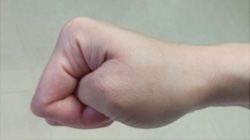Health Articles
What is De Quervain syndrome or mommy's thumb
De Quervain syndrome or mommy’s thumb, is tenosynovitis of the sheath that surrounds the two tendons that control of movement of the thumb. The two involved tendons are extensor pollicisbrevis (EPB) and abductor pollicislongus (APL) muscles. This two tendons play the role of moving the thumb away from the hand in the plane of the hand—so called radial abduction. De Quervain's is more common in women; the speculative rationale for this is that women have a greater angle of thestyloid process of the radius. The cause of de Quervain syndrome is still not well known and remains idiopathic. Some claim that this is likely to be caused by overuse injury in which repetitive movements of the thumb is a contributing factor. However, there is no scientific data supporting the link between overuse injury and de Quervain syndrome. Symptoms are pain, tenderness, swelling over the thumb side of the wrist, and with difficulties in gripping.
Finkelstein's test is used to diagnose de Quervain syndrome in people who have wrist pain. To perform the test, the examining physician grasps the thumb and the hand is ulnar deviated sharply, as shown in the image. If sharp pain occurs along the distal radius (top of forearm, about an in inch below the wrist) de Quervain's syndrome is likely.

De Quervain syndrome can be treated both conservatively and aggressively. The most common conservative treatment applied by physicians is the injection of corticosteroid to the lesion site. However, as of today, there are no sufficient evidences indicating that corticosteroid injection is beneficial for De Quervain syndrome or can decrease the recurrence rate of De Quervain syndrome. In physical therapy, ultrasound diathermy, shortwave diathermy, and transcutaneous electrical nerve stimulation (TENS) can be applied to the lesion site to alleviate the pain and inflammation caused by De Quervain syndrome.
Sometimes De Quervain syndrome can resolve by itself from adequate resting of the thumb. Occupational therapy palliative treatment of using a splint to immobilize the wrist and the thumb to ensure total rest of the thumb can be beneficial for the patient as well. Patients can take non-steroidal-anti-inflammatory drugs (NSAIDs) to ease the pain caused by De Quervain syndrome. A more aggressive treatment option for De Quervain syndromeis the application of surgery. This is done by surgical longitudinal resection of the sheath of the first dorsal compartment. It is documented that pain can be relieved through this surgical technique. However, it is essential that the radial sensory nerve must not be injured.
Review Date: May 19, 2013
Reviewed by: Dr. Chen, Carl P.C., Medical Director, Department of Physical Medicine and Rehabilitation, C.G.M.H. Taipei.
References:
1. ZEESHAN, M., AHMED, F., KANWAL, D., KHALID, Q. S. & AHMED, M. N. 2009. Guyon's canal syndrome due to tortuous ulnar artery with DeQuervainstenosing tenosynovitis, ligamentous injuries and dorsal intercalated segmental instability syndrome, a rare presentation: a case report. Cases J, 2, 9390..
2. TONINI, S., CANDURA, S. M., LANFRANCO, A. & MENNOIA, N. V. 2011. Carpometacarpal subchondral cysts due to repetitive movements in shoemaker: a case report. Int J Occup Med Environ Health, 24, 414-7.